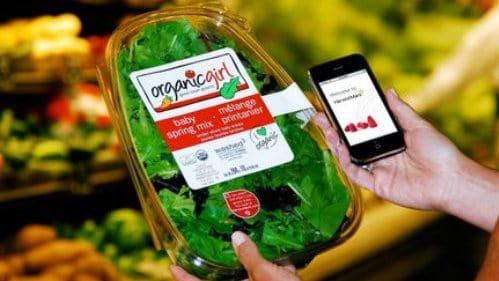Active Intelligent Packaging for Enhancing Food Quality and Safety

Intelligent packaging is an emerging technology that has the potential to revolutionize the food industry. By incorporating sensors and other smart features into packaging, intelligent packaging can provide real-time information about the condition of food products and help to ensure their quality and safety.
Active packaging and intelligent packaging are closely related concepts. The term “active packaging” refers to a package that serves purposes beyond only containing and safeguarding food products.
In order to preserve the quality and safety of various foods and food products, the present review’s goal is to stipulate knowledge of recent technical developments in the field of intelligent food packaging.
This technology is still in its early stages, but it has already shown promise in several applications, including detecting spoilage and extending shelf life.
Benefits of Active Intelligent Food Packaging: For Industry and Customers
Intelligent packaging is an emerging technology that has the potential to revolutionize the food industry. By incorporating sensors and other smart features into packaging, intelligent packaging can provide real-time information about the condition of food products and help to ensure their quality and safety.
For example, a package could be equipped with a sensor that would detect when a food item is spoiled and send a notification to the consumer. This would allow for better quality control and could potentially reduce food waste.
In addition to quality control, intelligent packaging can also be used to track the provenance of food items. This information can be used by consumers to make more informed choices about the food they purchase, as well as by businesses to improve their supply chain management.
For example, if there was a recall of a certain food product, businesses would be able to quickly identify which packages were affected and take appropriate action.
Principles of Active Intelligent Food Packaging
Intelligent food packaging is a concept that is being developed to help extend the shelf-life of perishable food products. The idea is to create packaging that can monitor the conditions inside the package and make adjustments accordingly. For example, if the temperature inside the package begins to rise, the packaging could adjust to allow for more ventilation.
One of the benefits of intelligent food packaging is that it could help to reduce food waste. If food products were able to stay fresh for longer periods of time, it would reduce the amount of spoilage and waste. Intelligent packaging could also help to improve food safety by providing real-time information about the condition of the food product.
At this time, active intelligent food packaging is still in development and has not yet been widely implemented.
Intelligent Packaging
Intelligent packaging is a game-changer for the food industry. By incorporating sensors and other smart technology into packaging, food companies can track the quality and safety of their products in real-time. This allows them to take immediate action if there are any issues, ensuring that consumers get the safest and most high-quality food possible.
Intelligent packaging is not only helpful for ensuring food quality and safety, but also for reducing waste. By being able to track the freshness of food products, companies can make sure that they are not selling or serving expired items. This not only protects consumers, but also helps businesses save money and reduce their environmental impact.
Overall, intelligent packaging is a major step forward for the food industry. By improving quality control and reducing waste, it is having a positive impact on both businesses and consumers alike.
Integration of Intelligent Devices with Conventional Food Packaging
The integration of intelligent devices with conventional food packaging can extend the storage life of food while monitoring for substances that might make the food unsafe to eat.
These devices can be used to monitor temperature, humidity, and other conditions inside the package, as well as track the movements of the package itself.
By using these devices, manufacturers can ensure that their products remain safe and fresh for longer periods of time, providing consumers with more choice and convenience.
Types of Active Intelligent Tools Used for Food Packaging
In this article, we will explore the different types of intelligent tools used for food packaging. This is an important topic because food packaging is a critical part of the food industry. It can protect food from contamination, extend its shelf life, and make it more convenient to store and transport. There are many different types of intelligent tools available for food packaging, and each has its own advantages and disadvantages.
Intelligent tools are increasingly being used in food packaging to improve safety and quality while reducing costs. Some of the most common types of active intelligent tools used in food packaging are vision systems, lasers, and robotics.
Sensors
Intelligent tools are being increasingly used for food packaging applications. These tools can be used to monitor the physical or chemical characteristics of food and can be either portable or fixed.
Portable chemical sensors are becoming more popular as they offer a quick and easy way to monitor the quality of food. These sensors can be used to measure the concentration of certain chemicals in food, such as oxygen, carbon dioxide, or pH levels. Fixed sensors are also being used more frequently in food packaging applications. These sensors can be used to monitor the temperature, humidity, or pressure inside a package.
Both portable and fixed sensors have their advantages and disadvantages. Portable sensors are typically more expensive than fixed sensors and may require more maintenance. However, portable sensors offer the advantage of being able to be moved from one location to another, which is not possible with fixed sensors.
The use of these intelligent tools is helping to improve food safety and quality control throughout the supply chain. In addition, they are also making it possible to package food in a more sustainable way by reducing waste.
Indicators
A new study has revealed that certain intelligent tools can be used for food packaging indicators. The study, conducted by a team of researchers at the University of Missouri, found that visual changes, colour, and time-temperature indicators can be used to detect the presence of microorganisms in food.
The research team tested various intelligent tools on two different types of food: ground beef and chicken breast. The results showed that the visual changes, colour, and time-temperature indicators were able to accurately detect the presence of microorganisms in both types of food.
“The use of intelligent tools for food packaging is a promising new technology that has the potential to revolutionize the way we monitor food safety,” said lead researcher Dr. Jennifer Linder. “This study is an important first step in demonstrating the feasibility of using these tools to detect pathogens in foods.”
Indicators are one type of tool that can be used for plastic food packaging. They can provide information about the visual changes, colour, time-temperature, and microorganism growth in foods.
Indicators can be used to monitor the progress of food spoilage and help prevent foodborne illness. By monitoring the changes in indicators, producers can make adjustments to processing and packaging conditions to prolong the shelf life of their products.
WARNING
Barcodes and Radio Frequency Identification Devices (RFID)
Intelligent tools are increasingly being used for food packaging. Barcodes and RFID allow for wireless communication between the packaging and the food product, providing a wealth of information about the product.
Barcodes are machine-readable codes that are printed on labels or packaging. They can be read by barcode scanners, which are commonly used in supermarkets and other retail settings. RFID tags are similar to barcodes, but they can be read without being in line of sight of the scanner. This makes them more versatile, as they can be read even if the tag is hidden inside a package or behind another object.
INFO
Other Intelligent Tools
Holograms
As the food industry becomes increasingly competitive, so does the need for better packaging. One way companies are protecting their brand names and products is by using holograms. Holograms are images that are three-dimensional, making them difficult to copy or tamper with. They can be placed on food packaging to help prevent counterfeiting and tampering.
Holograms are just one of the many tools being used to create better food packaging. With the help of technology, companies are able to protect their products in a variety of ways. By using holograms, they are able to create a unique image that cannot be duplicated. This helps to ensure that the product is safe and has not been tampered with.
ThermoChromic Inks
Intelligent tools are being used more and more in the food packaging industry.
One such tool is thermochromic inks. These inks change color when exposed to different temperatures, making them ideal for use on beverage packaging and microwave food products. The inks can be used to indicate whether a product is hot or cold, and whether it needs to be served immediately or not.
This helps consumers make informed decisions about the food they purchase, and ensures that they are getting the best possible product.
Decision Support System for Intelligent Food Packaging
A decision support system (DSS) is a computer program that aids in the decision-making process. DSSs are used extensively in the business world and are increasingly being used in food packaging. Intelligent food packaging is a type of packaging that uses sensors to monitor the condition of food and provide information about the food to consumers.
There are many benefits to using DSSs for intelligent food packaging. DSSs can help reduce food waste, ensure the safety and quality of food, and provide information about the nutritional content of food. Additionally, DSSs can help companies save money by reducing the need for manual inspection of food products.
INFO
Active Intelligent Packaging for Enhancing Food Quality and Safety: Conclusions
There are many different types of intelligent packaging tools available on the market to help with food packaging. Some of these tools are designed to help with portion control, while others are designed to help with keeping track of expiration dates.
In conclusion, intelligent packaging is a tool that can be used to enhance food quality and safety. When used correctly, it can help to extend the shelf life of food products and prevent spoilage. It can also help to identify potential hazards and ensure that food products are safe for consumption.






